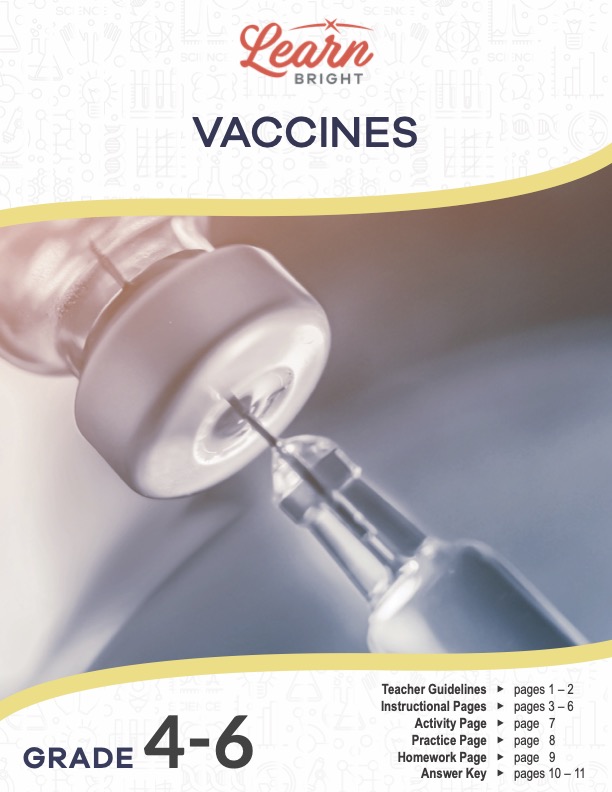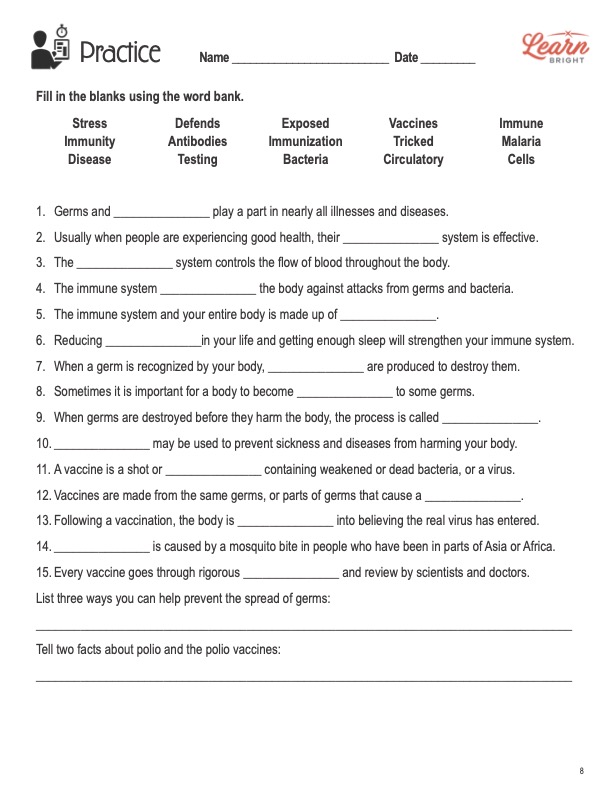Description
What our Vaccines lesson plan includes
Lesson Objectives and Overview: Vaccines introduces students to what a vaccine is and what it does for the body. Students will discover how exactly these work to help immunize people from various diseases and sicknesses. They will also learn about the history and development of vaccines. This lesson is for students in 4th grade, 5th grade, and 6th grade.
Classroom Procedure
Every lesson plan provides you with a classroom procedure page that outlines a step-by-step guide to follow. You do not have to follow the guide exactly. The guide helps you organize the lesson and details when to hand out worksheets. It also lists information in the yellow box that you might find useful. You will find the lesson objectives, state standards, and number of class sessions the lesson should take to complete in this area. In addition, it describes the supplies you will need as well as what and how you need to prepare beforehand. This lesson requires colored pencils, markers, construction or poster paper, and scratch paper. Students will also need access to the internet.
Options for Lesson
You can check out the “Options for Lesson” section of the classroom procedure page for additional suggestions for ideas and activities to incorporate into the lesson. For the Vaccines lesson plan, one idea is to assign a disease to each student to research and design a presentation for the class that focuses on the vaccine for that disease. Another options is to invite a doctor (or the school nurse) to speak with students about vaccines and answer any questions they have. You could also introduce a vaccine chart to students that displays various vaccines and the ages at which people usually get them. You may also benefit from discussing myths about vaccines. As another assignment, students could write an imaginative, creative story from the perspective of a weakened or dead virus. One more option is to have students research the history of vaccines or research diseases from the past that now have vaccines to help prevent people from contracting those diseases.
Teacher Notes
The teacher notes page provides an extra paragraph of information to help guide the lesson and remind you what to focus on. It emphasizes that this lesson focuses on how vaccines work and why they are effective in combatting illnesses. The blank lines on this page are available for you to write out thoughts and ideas you have as you prepare the lesson.
VACCINES LESSON PLAN CONTENT PAGES
The Immune System
The Vaccines lesson plan has four content pages. It begins by reminding students that it is almost impossible for a person to never get sick. A large variety of things can cause people to become ill. Of course, germs and bacteria—and even allergies—play a part in some illnesses. It is not fun to be sick. Even though we might get to sleep in and watch TV all day, there’s still something bad happening in the body.
When people are in good health, it means their immune system is working. The immune system is responsible for keeping the body safe from invading germs that try to attack it. The immune system involves several different organs of the body. It works together with the circulatory system, which controls the flow of blood throughout the body, to keep the body in good health.
The immune system consists of cells, just like the rest of the body. It works like a fort protecting the body and will increase its defenses when necessary. However, all forts need help, too. Alone, the immune system cannot stop every germ from causing harm to the body. It often needs help from other sources. Two simple ways to keep the immune system healthy is to reduce stress and to get enough sleep each night. Eating write, exercising, and washing hands are other important things we can do to prevent the spread of germs.
Immunity
Cells reproduce, and just like cells, disease germs that enter our bodies can reproduce as well. The immune system often recognizes these bad germs and bacteria. When it does, it produces antibodies to destroy the germs that would try to make us sick. Sometimes the antibodies don’t always prevent us from getting sick, but they will “remember” those germs the next time they decide to invade again.
In this way, the germs can actually help the immune system become stronger. When the body remembers the bad germs that attacked previously, it is then ready to fight back if they try to cause problems again. And when this happens, the antibodies will immediately destroy the germs before they have a chance to cause any issues. The entire process is called immunity, or natural immunity.
People who get diseases like chicken pox or measles will usually
never get the disease again because the antibodies fighting the illnesses stay with the body forever. The person’s body builds up a natural immunity against the diseases. There’s also another way to create immunity to help fight certain illnesses.
Vaccines
Besides natural immunity as described above, people can use vaccines to prevent sickness and diseases from affecting their body. A vaccine is a shot or immunization that contains weakened or dead bacteria (or a virus) to increase protection against a disease. In other words, a vaccine develops the immunity for the body against the disease or sickness.
Vaccines are made from some of the same, or parts of, germs that cause the disease. For example, a polio vaccine is made from a weak or dead polio virus. In essence, vaccines trick a person’s body into thinking it is being attacked by the real virus. Their body then produces antibodies to protect it from the virus or disease, sometimes for the rest of their life.
Types of Vaccines
Students will learn that there are many types of vaccines, such as the polio vaccine referred to earlier. Polio was once a disease that affected many people, often causing paralysis and even death. Today, because of the polio vaccine, about 80% of the world lives in polio-free zones. The lesson provides a chart of other vaccines and some information about each one.
Chickenpox is a common sickness. It’s highly contagious, but once a person has gotten once, they become immune for life. Symptoms that indicate chickenpox include itchy blisters and rashes, fever, headaches, and fatigue. Because of the chickenpox vaccine, the number of cases of people contracting the sickness has fallen over 90%.
When it comes to the flu (influenza), there actually two types. Doctors suggest people get a flu vaccine every year. The flu causes fever, chills, sore throat, cough, body aches, headaches, fatigue, and others. Most people get sick between December and February. Deaths that were caused by the flu have ranged from 3,000 to 49,000 in one year.
Likelihood of Getting Sick
It is not necessary for every person to get a vaccine against a disease or sickness. For example, malaria is usually caused by a mosquito bite. Most malaria cases in the U.S. occur in people who have visited certain parts of Asia or Africa. And a mosquito bite in the United States will not likely cause a disease.
In addition, flu vaccines are often recommended for young people and older citizens because these are the most vulnerable demographics. The more people who get a vaccine, the less of a chance there is that a disease or sickness will spread to others. For example, if no one in a classroom ever received a vaccine for measles, the chance one or more students gets measles would be high.
However, if 23 out of 25 kids in the class get the vaccine, the likelihood that someone in the class will come down with measles is very low, even for the two people who did not get the vaccine. In other words, the higher the number of people who have the vaccine, the less likely a contagious disease can be spread to someone who did not get the disease.
Furthermore, people who are not vaccinated can spread diseases to certain other vulnerable groups. Such groups include children who are too young to be vaccinated, people with weakened immune systems, and other people who are unable to be vaccinated.
VACCINES LESSON PLAN WORKSHEETS
The Vaccines lesson plan includes three worksheets: an activity worksheet, a practice worksheet, and a homework assignment. Each one will help students solidify their grasp of the material they learned throughout the lesson. You can refer to the classroom procedure guidelines to know when to hand out each worksheet.
INFORMATION POSTER ACTIVITY WORKSHEET
Students will work with a partner for the activity. Each pair of students must use the supplies you provide to create a poster that encourages people to get a vaccine and have their children vaccinated. Students should include persuasive language, supportive statements, other creative elements. They must also have pictures (hand-drawn or printed/cut out), logos, and so on. The poster should also have the names and details of some of the diseases students learned about.
Students can use scratch paper to sketch their poster ideas. There is a box at the bottom of the worksheet that they can use as well. Once they decide on a final product and you approve it, students can begin the final copy of the poster. After everyone finishes their posters, each pair of students will present theirs to the class.
FILL IN THE BLANK PRACTICE WORKSHEET
For the practice worksheet, studnets will fill in the blanks of 15 sentences. A word bank at the top of the page provides the possible answers for these sentences. At the bottom of the page are two prompts for students to respond to. One asks about ways to prevent the spread of germs. The other asks students to write two facts about polio and the polio vaccine.
VACCINES HOMEWORK ASSIGNMENT
The homework assignment splits into two sections. On the first section, students will match descriptions to the correct term. There are 12 descriptions but only eight terms. Four of the terms will correspond to more than one sentence. The second section requires students to mark whether each of eight statements is true (T) or false (F).
Worksheet Answer Keys
The lesson plan document provides answer keys for the practice and homework worksheets. All the correct answers are in red to make it easy for you to compare them to studnets’ responses. There may be some variation on the final two prompts of the practice worksheet. If you choose to administer the lesson pages to your students via PDF, you will need to save a new file that omits these pages. Otherwise, you can simply print out the applicable pages and keep these as reference for yourself when grading assignments.









